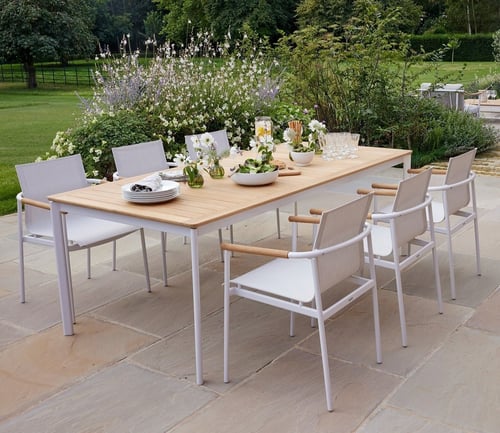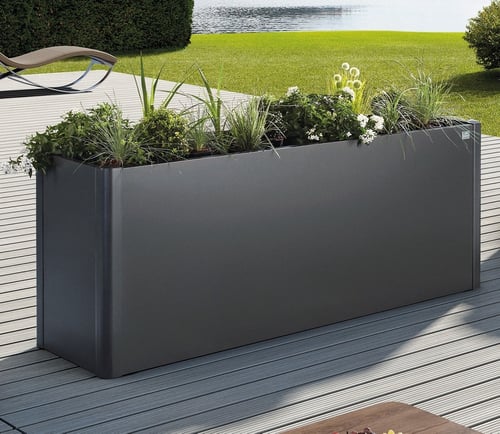The clearest indication that the seasons are changing is when the lush green leaves start to turn yellow and brown before falling to the floor. To collect them from both your lawn and paths is important as any rain will turn leaves into a potentially dangerous skiddy surface.
Leaf mould
You might find a pair of leaf grabbers useful to collect the leaves, but don't burn any of them as Leaf Mould has a veriety of uses. Store the leaves in a black plastic with a few holes poked through. Shred thicker leaves such as chestnut and sycamore to quicken the process, and after six months the contents of the bag can be used as a mulch, potting plants when mixed with sharp sand and compost, or on its own for sowing seed.
Other garden cuttings and plants that have had their day in the sun can be composted. The process isn't complicated, you can build you own or purchase a compost bin and we have a comprehensive composting guide.
Plant spring bulbs
Early September is the ideal time to buy spring flowering bulbs, plant them now a fabulous display of colour in the spring. Bear in mind that tulips should be purchased and planted later in the year. Bulbs will do well in any soil as long as it's well drained. If you happen to have clay soil, dig deeper than usual and plant the bulbs on grit or else the bulbs will rot.
Our favourite daffodils include February Gold, yellow and white Jack Snipe, the classic and very popular King Alfred, Cassata with an open yellow trumpet shaped like butterfly wings, and Golden Ducat which is a pure yellow double form
Be careful to plant the right way up, with the 'nose' at the top. Planting depth will depend on the type of bulb but normally twice or three times as deep as the bulb will suffice. If the bulbs are too shallow they will not flower.
Plant bulbs in groups where there is full sun or semi-shade although bluebells and crocuses prefer more dappled shade. Locations can be quite varied. Think about filling the border with colour before shrubs come into flower or naturalize them in the lawn. For the latter, scatter the bulbs and plant them in a haphazard fashion using a bulb planter and then putting back the grass and earth.
Bulbs also look superb in containers which can of course be moved around the garden to where they look most effective. After the bulbs have flowered, the containers can be moved out of view.
Foliage should only be removed after it has died off, the bulb uses the foliage to gather energy, so don't tie the leaves either.Feed the bulbs with a recommended fertilizer such as seaweed or liquid manure. If they are in a planter a high potash fertilizer would be suitable. A mulch of well rotted manure or compost would also be advisable if they are in a border.
If the bulbs are naturalized you can't cut the particular area of grass where they are located for several weeks, so early flowering bulbs may be preferred.
Take softwood cuttings
If you take cuttings from tender perennials such as fuchias, gazanias and geraniums and protect them over winter you'll be rewarded with lots of free plants in the spring. Tender plants are also worth propagating in case we have a hard frosts or they don't survive several weeks in their greenhouse winter quarters.
If you have any lavender, salvia, hebe, verbena or penstemon, take end of season cuttings that will take root before they become dormant.
Cut off the end of a non-flowering shoot about 5ins long just above a leaf. Remove any lower leaves. Make a clean cut just below a leaf joint, leaving a cutting that is about 4ins. Fuchsias are an exception, preferring to root from shorter cuttings, maybe only one or two inches.
Now plant the cuttings, perhaps with a dusting of hormone rooting powder, to about half of their length around the edge of a small pot filled with compost, a little sharp sand or grit should be added to improve drainage.
Water and then cover all but geraniums, and any other cutting with soft downy leaves, with a small plastic bag to conserve moisture and encourage humidity. After about six weeks this can be removed.
Stand the pots in good light but not direct sun. Water sparingly and remove any dead leaves, flowerbuds or cuttings that wilt and have clearly not taken.
In late March or early April you can pot the rooted plants individually and feel very pleased with yourself.
Rejuvenate the lawn
The tired looking lawn can be rejuvenated with specialist autumn lawn care products. Don't be tempted to use spring lawn care as it will be nitrogen based to produce soft new growth. To survive cold winter weather your lawn needs the the phosphate and potash found in an autumn feed. We have a useful guide with everything you know about how to achieve the perfect lawn.
Autumn pruning
Pruning includes jobs as large as cutting off tree limbs to deadheading flowers, some plants will thrive with only limited pruning while others need hard pruning.
Although initial pruning may be little more than cosmetic, eliminating crossing or weak shoots, before starting serious pruning you need to understand the plant's flowering habit and growth pattern.
Knowing fruiting and flowering characteristics is vitally important, whether it takes place on the current year's shoots or on ones that are more than a year old.
Knowledge of the plant's life cycle will also determine when to prune, generally pruning should allow the maximum growing period to produce flowering shoots or growth that will flower during the following season.
Naturally you are reluctant to remove healthy growth, however in the long term most trees will benefit from early training and pruning to create a strong framework of branches, especially if they are grown formally.
Disease and pests usually see their chance to strike when a plant is in poor condition, so it's important to prune out all damaged, dead and diseased wood, the '3 D's' as the RHS book calls them. Cut back to healthy wood, preferably a growth bud, from where replacement shoots can grow.
Clearing out the centre of a tree to rid it of weak shoots is important to increase air circulation and allow healthy ones to develop unhindered.
Awkwardly placed shoots may upset the symmetry of many shrubs and trees, these should be cut out. Sometimes plants become unbalanced due to one portion growing faster than the remainder, in this case lightly prune strong shoots but cut weak shoots back hard.
Collect seed
When you see that the seeds have darkened and are ready to drop from a plant, wait for a dry day, arm yourself with a paper bag and get out into the garden to collect the ripest. Either pick them from the plant, cut off the seed head or shake the seed directly into the bag. Only collect from healthy pest free plants.
Native plant seeds can be sown immediately in gritty compost. These include Angelica, Foxglove, Sweet Cicely and Yarrow. Sow in seed compost using a 3in pot or in a seed tray and cover in a protective layer of grit before leaving outside in a sheltered position. Water sparingly if the compost dries out.
The cold and inclement winter conditions will then break down the protective seed covering and promote germination. If you want to appear knowledgeable, this is called 'stratification'.
To break the seeds dormancy you can also place them in your refrigerator for a month and then sow them when they start to sprout.The resultant seedlings can then be potted on singly and planted out when they are large enough.
Many seeds don't require frost to germinate and will need to be stored until the spring. The list of these includes Cosmos, Lovage, Marigold and Sunflowers.
After collection, you can sift the seed heads to remove the chaff and leave only the seeds. Dry and store the seed in a cool and dark place. Use paper bags or food containers with a sachet of silica gel.
Some can be started off in a greenhouse during the early spring when they will appreciate only a little water in the morning. They can then be potted on in a similar fashion to native plants.
Note that seeds from hybrid plants may not be worth collecting, they will either not be viable or will not have the same properties as the specially bred parent plant.
Cover garden furniture
Covering expensive garden furniture and equipment is also important. You really don't want to be met with chairs and tables covered in grime next spring, so use use waterproof covers from Bosmere and individual furniture manufacturers that are specially shaped to fit furniture and hammocks as well as barbecues. Read our guide to Garden Furniture Covers.
Protect tender plants
The colder weather and any early frost can reek havoc if you have plants outside that aren't fully hardy, so use fleece to protect them. Very lightweight yet strong, fleece is easy to cut and will also provide a barrier against birds, insects and wind damage. To protect greenhouse plants and keep heating costs to a minimum use bubble wrap on the inside of greenhouse glazing for insulation.















